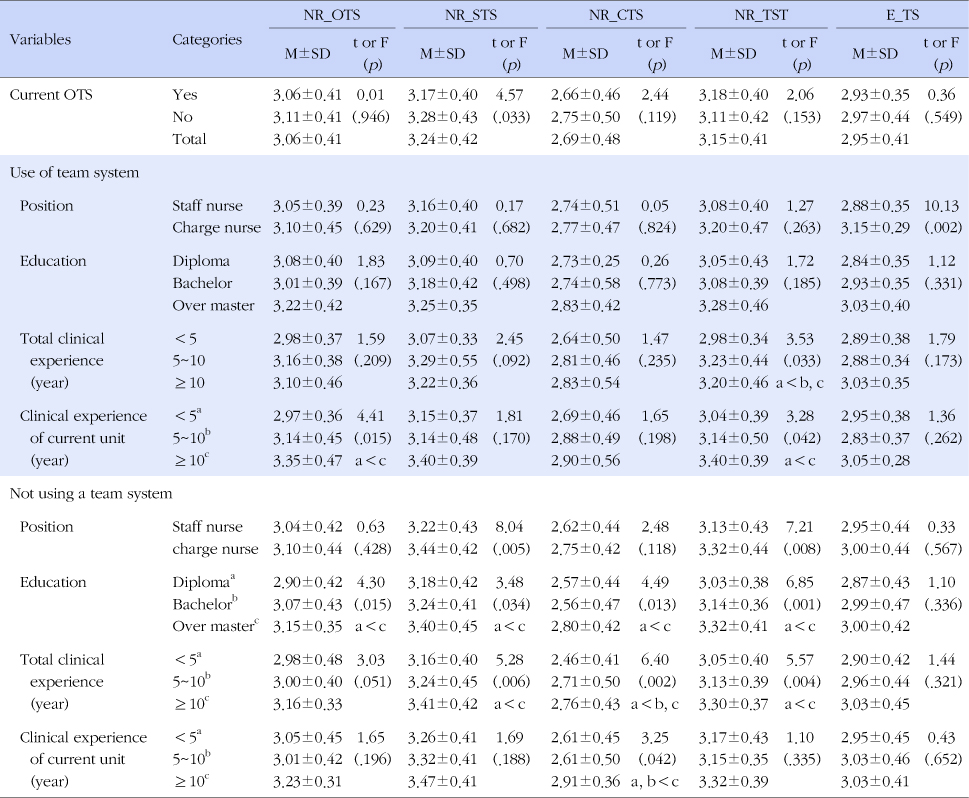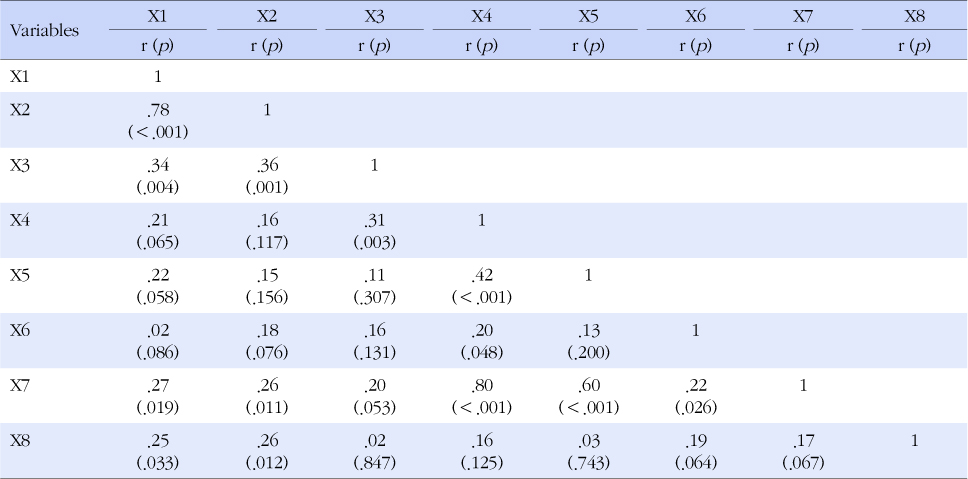1Department of Nursing, Sunchon National University, Korea.
2Department of Nursing, Kyungmin College, Korea.
3College of Nursing, Gyeongsang National University, Korea.
Copyright © 2014 Korean Academy of Nursing Administration
This is an open access article distributed under the terms of the Creative Commons Attribution Non-Commercial License (http://creativecommons.org/licenses/by-nc/3.0/), which permits unrestricted non-commercial use, distribution, and reproduction in any medium, provided the original work is properly cited.
This study was approved by Sunchon National University IRB(cnu1-201305-HR-001-02) & Seoul Asan hospital IRB(AMC 2013-0920).

OTS=Organizational team structure; NR_OTS=Nurses' recognition of operation of team structure; NR_STS=Nurses' recognition of organizational structure of team structure; NR_CTS=Nurses' recognition of culture of team structure; NR_TSt=Nurses' recognition of team structure, total; E_TS=Effects of team structure.

X1=Age; X2=Total clinical experience; X3=Clinical experience in current unit; X4=Nurses' recognition of operations of team system; X5=Nurses' recognition of organizational structure of team system; X6=Nurses' recognition of culture of team system; X7=Nurses' recognition of team system, total; X8=Effects of team system.

X1=Age; X2=Total clinical experience; X3=Clinical experience in current unit; X4=Nurses' recognition of operations of team system; X5=Nurses' recognition of organizational structure of team system; X6=Nurses' recognition of culture of team system; X7=Nurses' recognition of team system, total; X8=Effects of team system.

General Characteristics according to Operation of Team System (N=247)
Note. Missing values are excluded.
ICU=Intensive care unit, OR=Operating room.
Factor Analysis of Nurses' Recognition of Organizational Team System
Comparison of Nurses' Recognition of Organizational Team System (OTS), Effects of Team System by General Characteristics
OTS=Organizational team structure; NR_OTS=Nurses' recognition of operation of team structure; NR_STS=Nurses' recognition of organizational structure of team structure; NR_CTS=Nurses' recognition of culture of team structure; NR_TSt=Nurses' recognition of team structure, total; E_TS=Effects of team structure.
Correlations of related Variables with Effects of Team System when use a Team System (N=99)
X1=Age; X2=Total clinical experience; X3=Clinical experience in current unit; X4=Nurses' recognition of operations of team system; X5=Nurses' recognition of organizational structure of team system; X6=Nurses' recognition of culture of team system; X7=Nurses' recognition of team system, total; X8=Effects of team system.
Correlations of related Variables with Effects of Team System when not using a Team System (N=148)
X1=Age; X2=Total clinical experience; X3=Clinical experience in current unit; X4=Nurses' recognition of operations of team system; X5=Nurses' recognition of organizational structure of team system; X6=Nurses' recognition of culture of team system; X7=Nurses' recognition of team system, total; X8=Effects of team system.
Note. Missing values are excluded. ICU=Intensive care unit, OR=Operating room.
OTS=Organizational team structure; NR_OTS=Nurses' recognition of operation of team structure; NR_STS=Nurses' recognition of organizational structure of team structure; NR_CTS=Nurses' recognition of culture of team structure; NR_TSt=Nurses' recognition of team structure, total; E_TS=Effects of team structure.
X1=Age; X2=Total clinical experience; X3=Clinical experience in current unit; X4=Nurses' recognition of operations of team system; X5=Nurses' recognition of organizational structure of team system; X6=Nurses' recognition of culture of team system; X7=Nurses' recognition of team system, total; X8=Effects of team system.
X1=Age; X2=Total clinical experience; X3=Clinical experience in current unit; X4=Nurses' recognition of operations of team system; X5=Nurses' recognition of organizational structure of team system; X6=Nurses' recognition of culture of team system; X7=Nurses' recognition of team system, total; X8=Effects of team system.